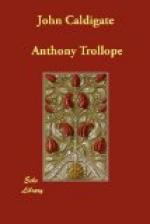Nevertheless he went to his work with great patience, and a resolve to sift everything that was to be sifted. The Secretary of State had done no more than his required duty in sending the case to him, and he would now do his. He took the counter-evidence as it came in the papers. In order that the two Bagwaxian theories, each founded on the same small document, might be expounded, one consecutively after the other, Dick Shand and his deposition were produced first. The judge declared to himself that Dick’s single oath, which could not now be tested by cross-examination, amounted to nothing. He had been a drunkard and a pauper,—had descended to the lowest occupation which the country afforded, and had more than once nearly died from delirium tremens. He had then come home penniless, and had—produced his story. If such evidence could avail to rescue a prisoner from his sentence, and to upset a verdict, what verdict or what sentence could stand? Poor Dick’s sworn testimony, in Judge Bramber’s mind, told rather against Caldigate than for him.
Then came the postmarks,—as to which the Bagwaxian theory was quite distinct from that as to the postage-stamp. Here the judge found the facts to be somewhat complicated and mazy. It was long before he could understand the full purport of the argument used, and even at last he hardly understood the whole of it. But he could see nothing in it to justify him in upsetting the verdict;—nothing even to convince him that the envelope had been fraudulently handled. There was no evidence that such a dated stamp had not been in use at Sydney on the day named. Copies from the records kept daily at Sydney,—photographed copies,—should have been submitted before that argument had been used.




